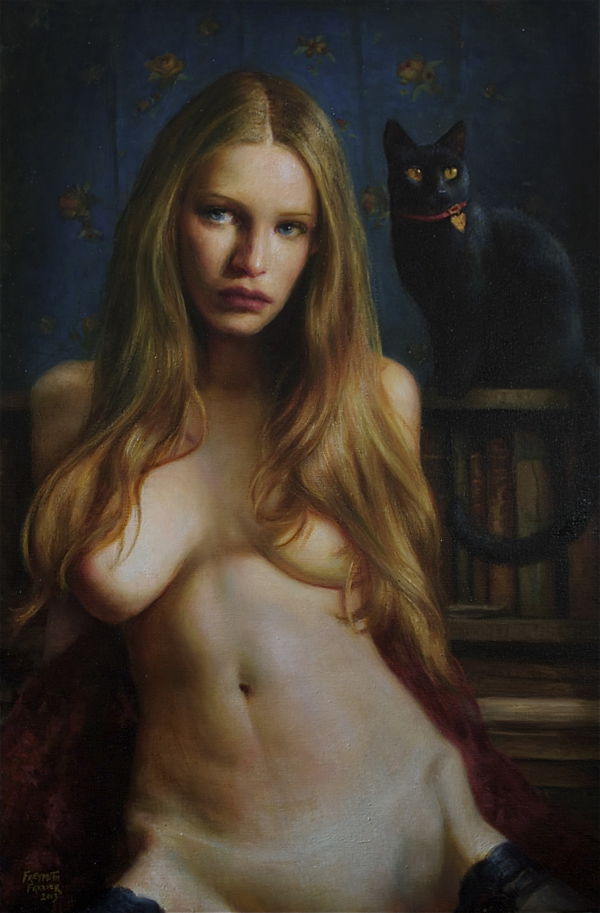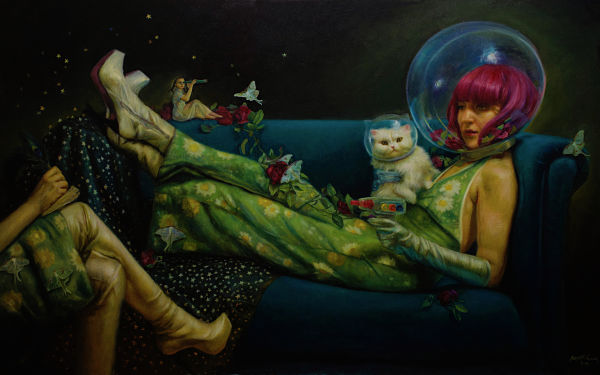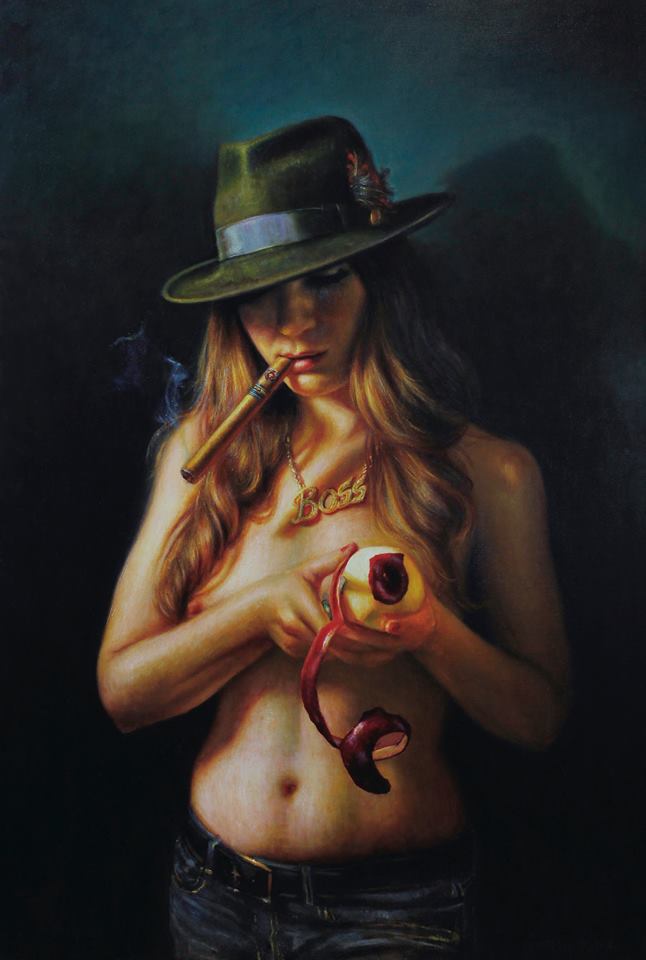 Rose Freymuth-Frazier is a figurative oil painter originally hailing from Nevada City, California. A 2018 Beautiful Bizarre Magazine Art Prize Finalist, her work has been exhibited on a global basis and her subject matter is often painted in such a way that is reminiscent of old masters such as Rembrandt and Caravaggio.
Rose Freymuth-Frazier is a figurative oil painter originally hailing from Nevada City, California. A 2018 Beautiful Bizarre Magazine Art Prize Finalist, her work has been exhibited on a global basis and her subject matter is often painted in such a way that is reminiscent of old masters such as Rembrandt and Caravaggio.
2019 Beautiful Bizarre Art Prize entries are now open! To be in the draw to win global exposure + over US$20,000 in cash and prizes, check out the details and enter today!
Rose manages to cross reference genres within her work because of this technique. I related to her work immediately as I, too, studied artwork for seven years and was drawn to the juxtaposition of the subject matter versus the style it was painted in. It’s as if each piece has its own dichotomy. Rose Freymuth-Frazier currently lives in New York City and has been a pleasure to work with.

Rose, although sometimes your subjects are in peril, they are still sexy. Do you identify with their gaze and intensity? Is there a part of you within every piece you create?
My women may at first appear to be in peril but they are strong in the face of adversity. Their sexuality is part of their strength. There’s an idea that all paintings are self-portraits in a way but these are really about experiences which are not necessarily my own, but rather a part of a larger experience of being a woman in our time. I’m happy to say things are rapidly changing culturally and some of the paintings feel like they were speaking to an earlier time. For example, finding the internal balance between masculine and feminine that I’ve included in my work is much more an accepted part of people’s experience now than a decade ago when I was painting about it.


I see the influence of Caravaggio with your intense lighting and would like to know who else you are inspired by in your work?
My technique is pretty straightforward, it’s reminiscent of the chiaroscuro employed by the old masters. However, my subject matter is informed by the world around me. I live in New York City where there’s a barrage of visual and mental stimulation. My work is influenced by everything from the Unicorn Tapestries at The Cloisters to advertisements for menswear.

Oil is your medium of mastery. Are there others you would like to experiment with? Any that intimidates you?
I would love to make a film. I started out studying theater and acting and always thought I’d go into film but painting came along. They are both forms of storytelling but one is much more quiet, slow and solitary than the other.


How do you choose your subject matter? Are they often friends or models through an open call? The women, I am referring to- although I want to know about the animals and fur babies as well please!
 I have hired very few models over the years. In my late 20’s and early 30’s, I basically just painted my friends. I felt it was more sincere than hiring models and the work was partially informed by what my friends were going through as young women. For example, “Sarah at Bat” was painted after a dear friend’s long-term relationship fell apart in a devastating way. The women in “Whispering Sisters” really are two sisters and I wanted to get a little of that sisterly bond, for better or worse.
I have hired very few models over the years. In my late 20’s and early 30’s, I basically just painted my friends. I felt it was more sincere than hiring models and the work was partially informed by what my friends were going through as young women. For example, “Sarah at Bat” was painted after a dear friend’s long-term relationship fell apart in a devastating way. The women in “Whispering Sisters” really are two sisters and I wanted to get a little of that sisterly bond, for better or worse.
Then there was a period where I painted found images of women from stock photos or Eastern European soft-core sites into new scenarios. If they were looking particularly cornered or vulnerable I created a different narrative by painting them into a position of power. “World Domination” and “In the Study” are examples of this.
Now I’m painting myself. I pretty much steered clear of self-portraits for a very long time. I wasn’t interested in making my work about me, but through a natural evolution I have come around to my latest series for which I am the model in each painting. They are my On the Couch series and since I’m using the template of the therapy couch they are more portraits of a psychological state allowing me to explore different aspects of myself.




For example, “Painted Ladies” is about being a female painter who paints and sells often nude women, in a field long dominated by men. There’s an interplay between masculine and feminine symbolism. I have donned the trope of painters of the past, a beret and a handheld wooden palette. I have a cigar, a symbol of masculinity and authority but an exposed breast; the blood red roses come from my heart and spill out onto the palette. I’m enjoying painting these pieces and am working on the fourth in the series.

The animal most often making an appearance is my Persian cat, Bun Ra. She was rescued from the streets of Giza, Egypt. There’s a real animal welfare problem there and good people are sending cats and dogs out of the country. I will admit we were attracted to her good looks but initially her personality left something to be desired. She just wasn’t socialized and now, after 2 1/2 years, she has really become a delightful little thing. She is a magical creature and I think the paintings are always better off when she makes an appearance.
Do you have any favorite pieces that were super hard to part with? If so, which piece and why?
I am happy to see my paintings go. They are meant to go on into other people’s lives. Although I do have a painting of Bun Ra the Cat silencing a Donald Trump cat toy/effigy hanging in our apartment and I enjoy having that around right now.
Your Etsy store gives collector’s access to your work at all price points. What made you decide to have a store? I appreciate this as I do not think I could afford a large canvas yet could afford small print runs.
I love sending prints out into the world. I’m grateful for every original painting sold but I am also not a fan of the elitism that permeates the art world. That’s why I have so many prints released. As long as people want them I will make them available at an accessible price.

Is there something you can tell me as a journalist that you have never told anyone else before with regards to your work?
The focus and concentration of painting sometimes drives me crazy. In my moments of greatest frustration I dream of playing Bossa Nova for a living at an island resort somewhere. The only problem is I don’t really know how to play Bossa Nova, but stay tuned!
I’d love to hear your thoughts on the Beautiful Bizarre Magazine Art prize: What was the process like for you? Did it meet your expectations? Why did you enter the Beautiful Bizarre Magazine Art Prize? What do you feel you have gained from this experience? Would you recommend it and encourage others to enter? If so, why?
I entered the Beautiful Bizarre Magazine Art Prize because I’m a big fan of the magazine. It seems there’s something of a renaissance happening for what I’d broadly call representational work and I think the magazine is making a sincere effort to cover it in all its facets. From the extreme big-eyed, New Contemporary to straight Figurative Realism, Beautiful Bizarre seems to be the go-to place to see it all. For a very long time there wasn’t such a publication so I’m really glad it’s around and thriving. The experience of entering the competition was simple, which I appreciated and I’d recommend it to anyone. I was totally surprised and delighted to be a finalist and I think having 20 finalists is a nice way to recognize a larger group of artists. It also translates to a physical exhibition curated by Beautiful Bizarre, which coherently presents the magazine’s vision through the choice of artists being spotlighted. It’s a diverse and interesting group in which I’m happy to be included.
What is next for you, Rose?
I’m exhibiting in Chicago and New York through the end of the year and will have a painting in a show in San Francisco this January. But I’m especially thrilled to be participating in my first museum exhibition in Germany next year. I’ll have one of my On the Couch paintings in a Beautiful Bizarre Magazine curated exhibition at Urban Nation, Museum for Urban Contemporary Art in Berlin next spring. This coincides with a renewed interest in my German-Jewish roots. I am in the process of applying for German citizenship, which my grandparents were stripped of, and I also hope to visit the large abandoned sanatorium outside of Berlin that belonged to my great-grandparents before it was confiscated by the Nazis. I’m interested to see how all of this may influence my work in the future.
Republished from Beautiful Bizarre Magazine.

